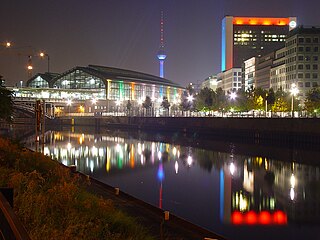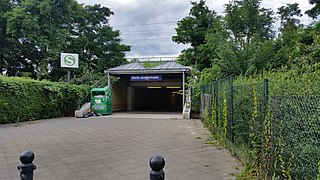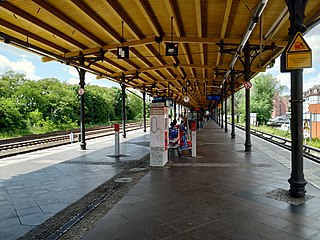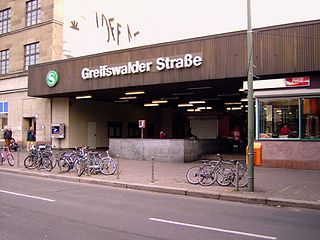
Neukölln is one of the twelve boroughs of Berlin, Germany. It is located south of Berlin's centre and stretches southeastwards to the city boundary, encompassing the localities of Neukölln, Britz, Buckow, Rudow and Gropiusstadt.

The Berlin S-Bahn is a rapid transit railway system in and around Berlin, the capital city of Germany. It has been in operation under this name since December 1930, having been previously called the special tariff area Berliner Stadt-, Ring- und Vorortbahnen. It complements the Berlin U-Bahn and is the link to many outer-Berlin areas, such as Berlin Brandenburg Airport. As such, the Berlin S-Bahn blends elements of a commuter rail service and a rapid transit system.

Berlin Jungfernheide is a railway station located at Charlottenburg-Nord, in the Charlottenburg-Wilmersdorf district of Berlin, served by the S-Bahn lines S41 and S42, the U-Bahn line U7 and Regional-Express trains of the Deutsche Bahn. Its name literally translates into "maidens' heathland"; it was named after the Jungfernheide, a former large forest in the proximity of this station.

Berlin Innsbrucker Platz is a railway station in the Schöneberg district of Berlin and located on the square of the same name. It is served by the Ringbahn lines S41, S42 and S46 of the Berlin S-Bahn. It is also the terminus of the U-Bahn line U4.

Berlin Frankfurter Allee is a railway station situated on Frankfurter Allee in the Friedrichshain district of Berlin, close to the district's border with Lichtenberg. It is served by the S-Bahn lines S41, S42, S8, S85 and the U-Bahn line U5.

The Berlin S-Bahn line 47 (S47) runs from Spindlersfeld to Hermannstraße. It operates over:

The Berlin S-Bahn line 46 (S46) runs from Königs Wusterhausen to Westend. It operates over:
The S4 line number was used by the Berlin S-Bahn between December 1997 and June 2002. The line acted as a temporary route for the re-opened parts of the Berlin S-Bahn ring until the complete ring was fully re-opened in June 2002. The ring is now served by lines S41 (clockwise) and S42 (counter-clockwise).

Berlin-Wedding is a station in the Wedding locality of Berlin and serves the S-Bahn lines S41 and S42 and the U-Bahn line U6.

Tempelhof is a railway station in the district of Berlin with the same name. It is served by the S-Bahn lines S41, S42, S45 and S46 and the U-Bahn line U6. The S-Bahn station is on an embankment at the junction of Tempelhofer Damm and Bundesautobahn 100, about 1 km south of the entrance to the former Tempelhof Airport. The U-Bahn station, officially called Tempelhof (Südring), is under Tempelhofer Damm immediately south of the S-Bahn station.

Berlin-Neukölln is a railway station in the Neukölln district of Berlin. It is served by the S-Bahn lines S41, S42, S45, S46 and S47 and the U-Bahn line U7.

Berlin Hermannstraße is a railway station in the Neukölln district of Berlin. It is served by the S-Bahn lines S41, S42, S45, S46 and S47 and the U-Bahn line U8, of which it is the southern terminus. It was formerly also possible to transfer there to the Neukölln-Mittenwalde railway line, which is now only used for goods traffic.

Berlin Westhafen is a station in the Moabit district of Berlin. It is served by the S-Bahn lines S41 and S42 and the U-Bahn line U9.

Berlin Bundesplatz is a railway station in the Wilmersdorf district of Berlin. It is served by the S-Bahn lines S41, S42 and S46 and the U-Bahn line U9.

The Ringbahn is a 37.5 km (23.3 mi) long circle route around Berlin's inner city area, on the Berlin S-Bahn network. Its course is made up of a pair of tracks used by S-Bahn trains and another parallel pair of tracks used by various regional, long distance and freight trains. The S-Bahn lines S41 and S42 provide a closed-loop continuous service without termini. Lines S45, S46 and S47 use a section of the southern and western ring, while lines S8 and S85 use sections of the eastern ring. The combined number of passengers is about 400,000 passengers a day. Due to its distinctive shape, the line is often referred to as the Hundekopf.

Berlin Gesundbrunnen station is a railway station in Berlin, Germany. It is situated in the Gesundbrunnen district, part of the central Mitte borough, as an interconnection point between the northern Ringbahn and Nord-Süd Tunnel lines of the Berlin S-Bahn, as well as a regional and long distance station of the Deutsche Bahn network. The station is operated by the DB Station&Service subsidiary of Deutsche Bahn AG and is classified as a Category 1 station, one of 21 in Germany and four in Berlin, the others being Berlin Hauptbahnhof, Berlin Südkreuz and Berlin Ostbahnhof.

Hohenzollerndamm is a station in the Wilmersdorf district of Berlin. It is served by the S-Bahn lines S41, S42 and S46. The station is located on the eponymous street named after the House of Hohenzollern. The neo-baroque entrance hall reminiscent of Art Nouveau design was erected in 1910.

Treptower Park is a railway station in the Alt-Treptow locality of Berlin. It is served by the S-Bahn lines S41, S42, S8, S85 and S9 and so represents an important interchange point on the Berlin S-Bahn network. The station consists of two island platforms, enabling cross-platform interchange between lines running in the same direction. It is located next to the park of the same name.

S-Bhf. Greifswalder Straße is a railway station in the Prenzlauer Berg district of Berlin. It is served by the S-Bahn lines S41, S42, S8 and S85.

The BVG Class 480 is an electric multiple unit for the Berlin S-Bahn. It was originally meant to replace the aging S-Bahn rail cars in West Berlin, but after the reunification of the city, the remaining orders were cancelled and replaced by new orders for DBAG Class 481 cars in 1993.




















